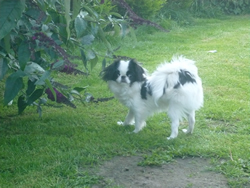Japanese Chin
 Kye |
Photo with thanks to Gemma |
See more Japanese Chin Pictures
Japanese Chin
Breeders & Puppies For Sale If your
a Japanese Chin breeder and have Japanese Chin puppies for sale, send us your details for free and we will add to our Japanese Chin Breeders page.
Japanese Chin
Rescue Center Visit the Japanese Chin rescue centers if your looking to rescue a Japanese Chin, as well as learn more about the breed or just support the rescue centers for there hard work.
Group Toy Dogs (KC)
Origin /
History The Japanese Chin, which is also called as the Japanese Spaniel, is a dog breed that's been existing for around a thousand years or more now. There are some theories stating that these dogs are distant descendants of Tibetan Spaniels. Even though these dogs are called Japanese Chins, there are theories that these dogs originated either in China's Sechuan province or in Korea. In China, these dogs were held in high regard and were among the preferred pets of emperors. Japanese royalty deemed these dogs as their favorite, thus, these dogs were closely guarded, pampered, and honored in imperial palaces. These dogs arrived in Europe probably during the 1600s, when Portuguese sailors gave some to Catherine of Braganza, the Queen Consort of King Charles II. These dogs were made more popular by Commodore Perry, who presented a pair to Queen Victoria. It was also through Commodore Perry's efforts that these dogs were able to reach the United States. The American Kennel Club bestowed recognition upon this breed in 1977.
Appearance Japanese Chins are little spaniels with broad, short faces, and feathered, soft coats. They have thick ruffs that cover their chests and necks. The color of their nose should match the color of their coat. They have almond-shaped dark eyes, and their ears are v-shaped, upside down, and covered with some hairs. Their coats are made up of silky, long, straight hairs.
Colours Their coats are white with patches of black, red, orange, lemon, brindle, or sable.
Temperament These dogs are lively, charming, and happy pets. They are loving, pleasant, and intelligent. They are affectionate and loyal to their owners. Although these dogs are known to be loving to all the people that they are familiar with, they tend to be shy around strangers and when faced with unfamiliar circumstances. These dogs can get along well with children, just as long as the children are considerate and nice to the dogs. These dogs can get along well with other canines as well as household pets. Aside from that, they are also more obedient than other dogs belonging to the toy group, and can be taught some tricks that it can perform.
Height and
Weight They can be from 18 - 28 cm in height and weight between 2- 3 Kg.
Common Health
Problems These dogs have tendencies to snore and wheeze. They are also susceptible to being afflicted with respiratory and eye problems. There are also some that may get distemper.
Living Conditions These dogs can be moderately active when kept indoors, making them suitable for apartment life. They do not need to be provided with a yard. Owners must keep in mind, though, that these dogs can be quite sensitive to extreme temperatures.
Exercise
Requirements Dogs of this breed do not need much exercise. They should, however, be taken on walks daily. These dogs also love it when they are given the chance to play around in secure, open spaces. Owners must make sure, though, that they do not overexert the dogs when the weather is hot.
Training Requirements Training these dogs are fairly easy since they are intelligent and eager to please. Basic obedience training must be started while the dogs are still young in order for them to grow up as well-mannered dogs. Methods of positive reinforcement will work well with these dogs. Training sessions must be interesting and short so that the dogs will have fun and enjoy their training. Proper socialization should also be done right from puppyhood to ensure that the dogs grow up to be well-adjusted and adaptable to various situations.
Life Expectancy These dogs are expected to live for around 10 to 12 years.
Grooming For owners who have just acquired their Japanese Chins, it would be best to ask help from a professional groomer about the proper technique of grooming these dogs. Coats of these dogs should be combed and brushed lightly for a few minutes every day to keep them looking beautiful. These dogs' eyes should be cleaned on a regular basis. Owners should also check their dogs' ears to see if there are any infections. Bathing must be done only when it is necessary, although dry shampooing the dogs can be done occasionally.
Famous Examples
CompleteDogsGuide Comment
Breeders
Comments: Send us yours comments, advice for owners, potential owners etc.
Owners Comments: Send us any of your comments. Thanks in advance.
More Japanese Chin Information: Check out our Japanese Chin Clubs and links to more informative websites dedicated to the breed.
Submit your Japanese Chin pictures Send us any pics of your Japanese Chin, let us know there name and age and any other details. We'll add to this page. Contact us
Photo with thanks to Gemma |
|

Fiona |
|

Kisses |

Tyler |
|
|